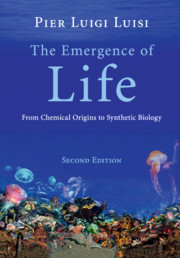Book contents
- Frontmatter
- Contents
- Acknowledgments
- Introduction
- Part I Approaches to the origin of life
- Part II What is life? The bio-logics of cellular life
- Part III Order and organization in biological systems
- Part IV The world of vesicles
- 11 The various types of surfactant aggregates
- 12 Vesicle reactivity and transformations
- 13 Biochemistry and molecular biology in vesicles
- Part V Towards the synthetic biology of minimal cells
- As a way of conclusion
- Appendix The open questions about the origin of life
- References
- Names index
- Subject index
12 - Vesicle reactivity and transformations
from Part IV - The world of vesicles
Published online by Cambridge University Press: 05 September 2016
- Frontmatter
- Contents
- Acknowledgments
- Introduction
- Part I Approaches to the origin of life
- Part II What is life? The bio-logics of cellular life
- Part III Order and organization in biological systems
- Part IV The world of vesicles
- 11 The various types of surfactant aggregates
- 12 Vesicle reactivity and transformations
- 13 Biochemistry and molecular biology in vesicles
- Part V Towards the synthetic biology of minimal cells
- As a way of conclusion
- Appendix The open questions about the origin of life
- References
- Names index
- Subject index
Summary
Introduction
Vesicles are good models for the outer shell of biological cells. This is due to the bilayer spherical structure, which is also present in most biological cells, and to the fact that they can incorporate biopolymers and host biological reactions. Vesicles also have the capability of self-reproduction, an autocatalytic reaction already illustrated in previous chapters. Some additional aspects of this process will be considered here, together with some particular properties of their growth – the so-called matrix effect.
We will begin with some theoretical, geometrical considerations, and then proceed to the experimental aspects.
Growth and division of vesicles: some geometrical relationships
The processes of changes of form and dimension in vesicles are generally linked to the relation between surface and volume. In order to consider this point more in detail, let us examine Figures 12.1, 12.2, and 12.3 (I am indebted to Pasquale Stano for planning these three figures and calculations therein; see also Stano et al., 2006).
Figure 12.1 illustrates the geometrical parameters characterizing division in the simplifying assumption of spherical vesicles, when division takes place with constant volume, or with constant surface, or with constant radius.
When the total volume remains constant, growth and division proceed at the expenses of added lipids, and finally the volume of each particle is one-half of the initial one. For the surface to remain constant, as in the second case, water has to leave in order to permit vesicle division, the surface of each obtained particle is then one-half of the initial one, and the final radius and volume are in a simple mathematical relation with the initial parameters.
Finally, if the division occurs with constant radius, the surface and the volume of each particle will be the same as the initial one, which means that both the final total volume and the final total surface will be twice as much as the initial one. Of course, in this case both water and lipids have to be added.
The Figure 12.2 illustrates some simple geometrical relationships in the case of surface growth by a generic factor α, as induced by lipid and water uptake, which brings about an increase of volume and surface.
- Type
- Chapter
- Information
- The Emergence of LifeFrom Chemical Origins to Synthetic Biology, pp. 297 - 318Publisher: Cambridge University PressPrint publication year: 2016



